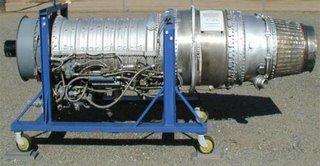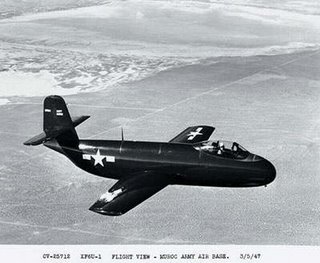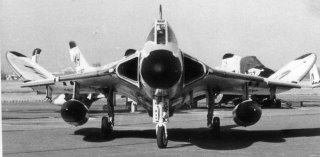Flightdeck Friday!
 Certain pairings, on the surface, seem to be made for each other – Bogie & Bacall, rum & Coke ®, etc. But balsa wood and afterburners? Almost seems counter-intuitive. This weeks feature is the Vought F6U Pirate, the Navy’s first composite-built and afterburner fighter.
Certain pairings, on the surface, seem to be made for each other – Bogie & Bacall, rum & Coke ®, etc. But balsa wood and afterburners? Almost seems counter-intuitive. This weeks feature is the Vought F6U Pirate, the Navy’s first composite-built and afterburner fighter.
By 1944 it was apparent from the reports being returned from the European theater of ops that the future lay in jets and the Navy soon joined the fray. In September 1944, BuAer (Bureau of Aeronautics) issued a specification for a single seat fighter to be powered by the Westinghouse J34 turbojet. As described in an earlier FF (see the F11F article), Westinghouse power plants were notoriously underpowered, the J40 being the death knell for otherwise good designs. Well, the J34 started the trend, mustering a mere 3K lbs of thrust.
the future lay in jets and the Navy soon joined the fray. In September 1944, BuAer (Bureau of Aeronautics) issued a specification for a single seat fighter to be powered by the Westinghouse J34 turbojet. As described in an earlier FF (see the F11F article), Westinghouse power plants were notoriously underpowered, the J40 being the death knell for otherwise good designs. Well, the J34 started the trend, mustering a mere 3K lbs of thrust.
With such miniscule power available, weight saving measures were the order of the day and Vought evidently thought they had a solution in the forms of their “Metalite” and “Fabrilite” materials. The former consisted of a sandwich of balsa wood between two thin aluminum sheets and would be used for most of the structure. The latter consisted of a fiberglass sandwich with a balsa wood core and was used for the vertical tail surfaces and inlet (see, the Hornet wasn’t the first plastic jet).
Alas, as inspired as the material solution might have been, the aircraft itself was, well, as underwhelming as its thrust. Looking much like a fat sausage with wings and empennage stuck on as an afterthought, the Pirate tipped the scales at just over 7,000 lbs. Empty. Gross was over 12K. Paint it pink and it probably would have been a suitable prop for a Pink Floyd concert...
 Be that as it may, it had to fly – which it did, badly. In an attempt to boost performance an afterburner section was added, giving it the dubious distinction of being the first a/b aircraft in the Navy’s inventory. Even at that, it added only another 1K lbs worth of thrust. Three prototypes and 30 production aircraft were ordered before it was (mercifully) euthanized in 1950 with BuAer’s report stating in part:
Be that as it may, it had to fly – which it did, badly. In an attempt to boost performance an afterburner section was added, giving it the dubious distinction of being the first a/b aircraft in the Navy’s inventory. Even at that, it added only another 1K lbs worth of thrust. Three prototypes and 30 production aircraft were ordered before it was (mercifully) euthanized in 1950 with BuAer’s report stating in part:
“The F6U-1 had proven so sub-marginal in performance that combat utilization is not feasible.”
Where are they now? Most ended up as fodder on weapons ranges in the southwest US, but one remains and is now under going restoration at the Vought plant in

Next week: Is there a FORD in your future?










|